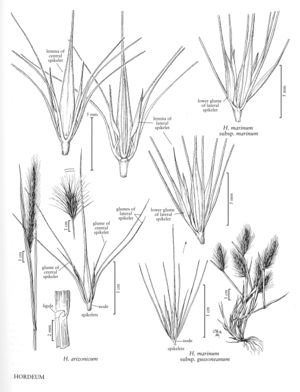Difference between revisions of "Hordeum arizonicum"
FNA>Volume Importer |
FNA>Volume Importer |
||
| Line 17: | Line 17: | ||
-->{{Treatment/Body | -->{{Treatment/Body | ||
|distribution=Calif.;Ariz.;N.Mex. | |distribution=Calif.;Ariz.;N.Mex. | ||
| − | |discussion=<p>Hordeum arizonicum grows in saline habitats, along irrigation ditches, canals, and ponds in the south¬western United States and northern Mexico. It is a segmental allopolyploid between H. jubatum and either H. pusillum or H. intercedens.</p> | + | |discussion=<p><i>Hordeum arizonicum</i> grows in saline habitats, along irrigation ditches, canals, and ponds in the south¬western United States and northern Mexico. It is a segmental allopolyploid between <i>H. jubatum</i> and either <i>H. pusillum</i> or <i>H. intercedens</i>.</p> |
|tables= | |tables= | ||
|references= | |references= | ||
| Line 26: | Line 26: | ||
-->{{#Taxon: | -->{{#Taxon: | ||
name=Hordeum arizonicum | name=Hordeum arizonicum | ||
| − | |||
|authority=Covas | |authority=Covas | ||
|rank=species | |rank=species | ||
| Line 33: | Line 32: | ||
|basionyms= | |basionyms= | ||
|family=Poaceae | |family=Poaceae | ||
| − | |illustrator=Cindy Roché | + | |illustrator=Cindy Roché;Annaliese Miller |
| + | |illustration copyright=Utah State University | ||
|distribution=Calif.;Ariz.;N.Mex. | |distribution=Calif.;Ariz.;N.Mex. | ||
|reference=None | |reference=None | ||
| Line 39: | Line 39: | ||
|publication year= | |publication year= | ||
|special status= | |special status= | ||
| − | |source xml=https:// | + | |source xml=https://jpend@bitbucket.org/aafc-mbb/fna-data-curation.git/src/f50eec43f223ca0e34566be0b046453a0960e173/coarse_grained_fna_xml/V24/V24_351.xml |
|subfamily=Poaceae subfam. Pooideae | |subfamily=Poaceae subfam. Pooideae | ||
|tribe=Poaceae tribe Triticeae | |tribe=Poaceae tribe Triticeae | ||
Revision as of 20:20, 16 December 2019
Plants annual to biennial, perennial under favorable conditions; forming small tufts. Culms 21-75 cm, rarely geniculate, not bulbous; nodes glabrous. Lower sheaths pub¬escent; upper sheaths glabrous; ligules 0.6-1.8 mm; auricles absent; blades to 13 cm long, to 4 mm wide, flat, glaucous, both surfaces scabrous, hairy, sometimes only sparsely hairy. Spikes 5-12 cm long, 6-10 mm wide, erect, often partially enclosed at maturity, pale green. Glumes bent, strongly divergent at maturity. Central spikelets: glumes 11-28 mm long, 0.2-0.4 mm wide, flattened near the base, setaceous above the middle; lemmas 5-9 mm, glabrous, awned, awns 10-22 mm; anthers 1-2.2 mm. Lateral spikelets sterile; glumes to 27 mm long, 0.2-0.4 mm wide, flattened near the base; lemmas 2.5-5 mm, unawned or awned, awns to 3 mm, lemma and awn together to 7 mm, the transition from the lemma to the awn gradual. 2n = 42.
Distribution
Calif., Ariz., N.Mex.
Discussion
Hordeum arizonicum grows in saline habitats, along irrigation ditches, canals, and ponds in the south¬western United States and northern Mexico. It is a segmental allopolyploid between H. jubatum and either H. pusillum or H. intercedens.
Selected References
None.
